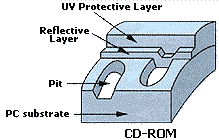
Introduction to CD Technology:
Data
is stored on a CD-ROM as a series of pits in a metallic layer. These pits do
not reflect the laser back to the detector, wheras the surrounding material
(known as the land) does. The data is read by shining a laser diode at the surface
and using a detector to determine if there is a reflection at that location,
i.e. if there is a pit or not. The recording process involves cutting a glass
master disc on a laser lathe and pressing copies from that master. 
This process is expensive and only available on the large scale, so a method of reproducing the "pits and lands" of a CD-ROM was needed. There were several requirements for this new technology. Firstly, the data had to be written by a low power red or infra-red laser, as these types are available as laser diodes and can be integrated into the drive. Secondly, the recording medium must be normally reflective to red light, but not if it has been "written" to. This is not a problem with conventional CDs as metal is reflective across the entire spectrum of visible and infra red light. The pits must also be stable with respect to their unmodified state, otherwise all the data will be lost over time. This stability must be high under normal circumstances and under the conditions of the reading laser, so that reading the data does not degrade the data integrity. The data integrity is often measured as a "signal to noise ratio". If the background noise increases with time or if the pits themselves become less well defined then the ratio falls and errors are more likely. Preventing errors is more important in data applications than in audio applications as even the best audiophile will not notice a few missing data in the music, but a few missing bits in a digital file will render it useless. The search for such a recording material began with metallic alloys and proceeded to research of organic dyes...